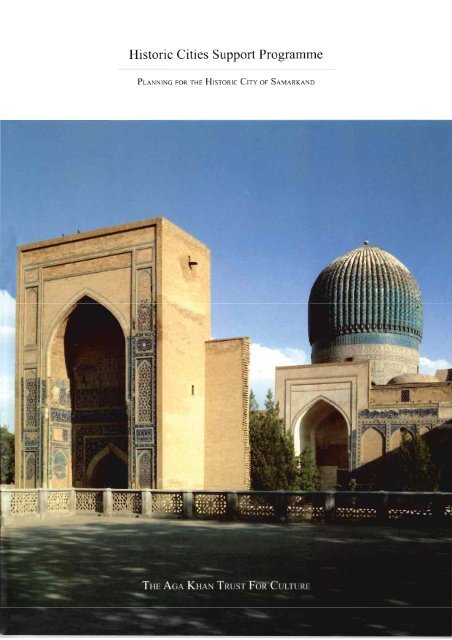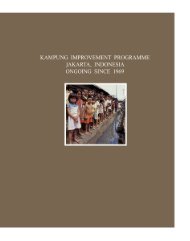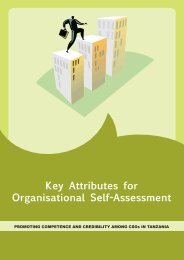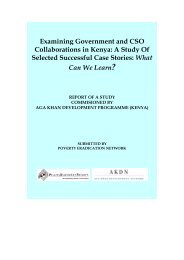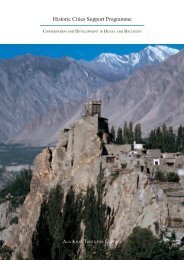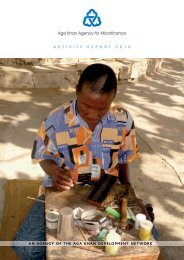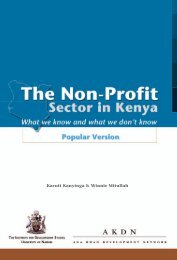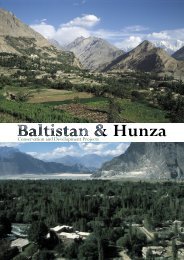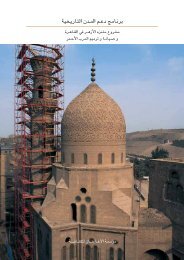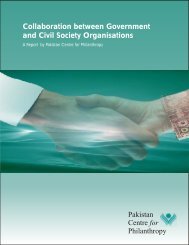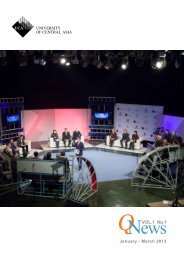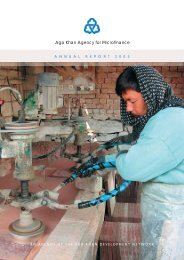166. Planning for the Historic City of Samarkand - Aga Khan ...
166. Planning for the Historic City of Samarkand - Aga Khan ...
166. Planning for the Historic City of Samarkand - Aga Khan ...
You also want an ePaper? Increase the reach of your titles
YUMPU automatically turns print PDFs into web optimized ePapers that Google loves.
INTRODUCTIONBy Stefano Bianca, Director, <strong>Historic</strong> Cities Support Programmeamarkand, <strong>of</strong>all <strong>the</strong> historic cities in <strong>the</strong> world, has always had a very special appeal due to<strong>the</strong> city spivotalposition along <strong>the</strong> fabled Silk Route, an early and major crossroads betweenEast and West. Merchants, monks and diplomatic envoys from <strong>the</strong> courts <strong>of</strong>Europe visited<strong>the</strong> Central Asian empires from <strong>the</strong> thirteenth century, and leftfascinating accounts <strong>of</strong>meetingsbetween two accomplished but very different peer civilisations. Over <strong>the</strong> centuries, <strong>Samarkand</strong>has been able to conserve <strong>the</strong> heritagefrom its Timurid heyday, a period which has gained new significancein <strong>the</strong> context <strong>of</strong><strong>the</strong> recent resurgence <strong>of</strong> Uzbekistan s national identity. The re-shaping <strong>of</strong>this identity iscoupled with its opening up to <strong>the</strong> world at large, facilitated by easier communications and matched by arising interest in Uzbekistan scurrent development on <strong>the</strong> part <strong>of</strong><strong>for</strong>eign countries, institutions and individuals.On <strong>the</strong> premise <strong>of</strong>such renewed cultural exchange, <strong>the</strong> <strong>Aga</strong> <strong>Khan</strong> Trust For Culture, based on an understandingbetween His Excellency Mr. Islam Karimov, <strong>the</strong> President <strong>of</strong>Uzbekistan, and His Highness <strong>the</strong> <strong>Aga</strong> <strong>Khan</strong>,started a number <strong>of</strong>initiatives in <strong>Samarkand</strong> in close co-operation with national and local authorities. Thefirst product <strong>of</strong>this involvement was <strong>the</strong> 1991 international idea competition <strong>for</strong> re-structuring <strong>the</strong> historiccity centre between <strong>the</strong> Registan and Timur s citadel, followed in 1992 by <strong>the</strong> prize-giving ceremony <strong>of</strong><strong>the</strong><strong>Aga</strong> <strong>Khan</strong> Award <strong>for</strong> Architecture in <strong>the</strong> Registan. Two years later, <strong>the</strong> Trust s <strong>Historic</strong> Cities SupportProgramme joined <strong>the</strong> Municipality <strong>of</strong><strong>Samarkand</strong> in a long-term co-operative ef<strong>for</strong>t to review and update<strong>the</strong> 1980 masterplan vis avis <strong>the</strong> historic city, and prepare more detailed rehabilitation proposals<strong>for</strong> certainkey areas in <strong>the</strong> old centre.The intention <strong>of</strong>this initiative, carried out with <strong>the</strong> help <strong>of</strong>two international consultants, is to set up a deeprootedco-operative institutional structure, involving <strong>the</strong> technical <strong>of</strong>fices <strong>of</strong><strong>the</strong> Municipality and key staffwithin <strong>the</strong> State Institute <strong>for</strong> <strong>Planning</strong> and <strong>the</strong> State Institute <strong>for</strong> Restoration, drawing on <strong>the</strong> resources <strong>of</strong><strong>the</strong><strong>Samarkand</strong> School <strong>of</strong>Architecture, and providing new opportunities<strong>for</strong>young Uzbek architects and planners.The first results <strong>of</strong>this joint working process, which will be deepened and expanded in <strong>the</strong> coming years,are presented in this brochure, produced upon <strong>the</strong> occasion <strong>of</strong> Timur s Jubilee in October 1996. Whereas<strong>the</strong> Trust s long-term objectives in <strong>Samarkand</strong> go beyond <strong>the</strong> time limits set by <strong>the</strong> Jubilee, <strong>the</strong> team used<strong>the</strong> period defined by this deadline to prepare a number <strong>of</strong>detailed planning proposals <strong>for</strong> <strong>the</strong> Gur-i Emirarea. The implementation <strong>of</strong>such complex projects will, however, require a more generous time frame.There<strong>for</strong>e, <strong>the</strong> Trust looks at <strong>the</strong> Jubilee as a starting point<strong>for</strong> a whole series <strong>of</strong>future rehabilitation projectsto be carried out by <strong>the</strong> <strong>Samarkand</strong> authorities in co-operation with <strong>the</strong> Trust, through <strong>the</strong> proposed new"Centre <strong>for</strong> <strong>the</strong> Revitalisation <strong>of</strong><strong>the</strong> <strong>Historic</strong> <strong>City</strong> <strong>of</strong><strong>Samarkand</strong>. " Notwithstanding <strong>the</strong> support <strong>of</strong>externaldonors, who will certainly need to be mobilised<strong>for</strong> special projects, <strong>the</strong> implementation process must relyas much as possible on local resources and capabilities.It is perhaps appropriate to introduce this report with afew remarks about <strong>the</strong> general philosophy underlying<strong>the</strong> collective approach employed by <strong>the</strong> working group. In essence, historic <strong>Samarkand</strong>s attraction stemsfrom <strong>the</strong> subtle interaction between three contrasting yet complementary factors: <strong>the</strong> grand scale andsplendour <strong>of</strong><strong>the</strong> city s monuments, <strong>the</strong> intimate qualities <strong>of</strong><strong>the</strong> closely knit residentialfabric as defined by4
its traditional low courtyard houses, and <strong>the</strong> beauty <strong>of</strong><strong>the</strong> irrigatedgardens which complement and occasionallypenetrate <strong>the</strong> urban tissue. Each one <strong>of</strong><strong>the</strong>se three elements has to be balanced with <strong>the</strong> o<strong>the</strong>rs in order topreserve <strong>the</strong> harmony <strong>of</strong>Sam arkands urbanfabric as a whole.lfindividual monuments are exhibited at <strong>the</strong>expense <strong>of</strong><strong>the</strong> surrounding urban fabric, <strong>the</strong>ir isolation can be detrimental to <strong>the</strong> unique character <strong>of</strong><strong>the</strong>historic nucleus without really adding to <strong>the</strong> appreciation <strong>of</strong><strong>the</strong> monuments <strong>the</strong>mselves. It may also blur <strong>the</strong>necessary distinction between historic and modern parts <strong>of</strong><strong>the</strong> city - especially when combined with <strong>the</strong>introduction <strong>of</strong>major axes <strong>of</strong>vehicular traffic. Similarly, <strong>the</strong> creation <strong>of</strong>large gardens inside <strong>the</strong> urbanfabric, unless incorporated in an appropriate architectural framework, may destroy <strong>the</strong> experience <strong>of</strong><strong>the</strong>historic city, while being <strong>of</strong>limited benefit to <strong>the</strong> actual users. In preparing <strong>the</strong> concepts and proposalsdescribed in this report, <strong>the</strong> team made an attempt to re-establish <strong>the</strong> balance between <strong>the</strong>se three interrelatedelements, andfollow up-to-date international principles <strong>of</strong>urban conservation.The work <strong>of</strong>our joint team <strong>of</strong>pr<strong>of</strong>essionals would not have been possible without <strong>the</strong> support <strong>of</strong><strong>the</strong> Uzbekauthorities. Our gratitude goes to His Excellency Mr. Ismail Jurebekov, First Deputy Prime Minister andChairman <strong>of</strong><strong>the</strong> Timur Jubilee Committee, to His Excellency Mr. Alisher Mardiyev, <strong>the</strong> Province Hokim <strong>of</strong><strong>Samarkand</strong>, and to His Excellency Mr. Aziz Nasirov, <strong>the</strong> <strong>City</strong> Hokim <strong>of</strong>Sam arkand who has supported thisprojectfrom its very beginning.Important encouragement to <strong>the</strong> team was also provided by Mr. Botir Usmanov, Chief<strong>of</strong><strong>the</strong> National Board<strong>of</strong>Monuments, Pr<strong>of</strong>essor Rustam Holmuradov, Rector <strong>of</strong><strong>the</strong> <strong>Samarkand</strong> State Institute<strong>for</strong> Architecture andConstruction, Pr<strong>of</strong>essor MuhammadAhmedov, Dean <strong>of</strong><strong>the</strong> Faculty <strong>of</strong>Architecture, and Pr<strong>of</strong>essor NematjonSadikov whose links with <strong>the</strong> Trust go back to 1989. In addition, <strong>the</strong> Uzbek Union <strong>of</strong>Architects under itspresident, Firouz Ashrafi, has supported <strong>the</strong> project team in its tasks and was <strong>of</strong>great help to <strong>the</strong> Trust insetting up <strong>the</strong> <strong>Samarkand</strong> project.Finally, I would like to thank all <strong>the</strong> Uzbek and expatriate pr<strong>of</strong>essionals who have carried out <strong>the</strong> workcontained in this report. In particular, I would like to acknowledge <strong>the</strong> generous contribution provided byPr<strong>of</strong>essor Galina Pugachenkova to <strong>the</strong> historical analysis <strong>of</strong><strong>the</strong> project area. Fur<strong>the</strong>r, Mr. AlexanderAlexandrovich <strong>of</strong><strong>the</strong> State <strong>Planning</strong> Institute in Tashkent contributed his great experience and knowledge <strong>of</strong><strong>Samarkand</strong> and co-operated closely with Francesco Siravo and Amir Pasic, who brought <strong>the</strong>ir expertisegained in <strong>the</strong> historic cities <strong>of</strong>Italy and <strong>the</strong> Award-winning Mostar project in <strong>the</strong><strong>for</strong>mer Yugoslavia. lzharHunzai outlined <strong>the</strong> community and economic development opportunities <strong>of</strong><strong>the</strong> Gur-i Emir project, and Dr.Mona Serageldin assisted <strong>the</strong> group in defining <strong>the</strong> structure andfunction <strong>of</strong><strong>the</strong>future "Centre<strong>for</strong> Revitalisaiion. "Special mention is due to <strong>the</strong> three young Uzbek architects, Farhod Bagirov. Shavqat Kurbanov, UlugbekTojiboyev, who. as part <strong>of</strong>a larger group <strong>of</strong>students, prepared <strong>the</strong> surveys and architectural projects <strong>for</strong><strong>the</strong> Gur-i Emir pilot area, with assistance from Hugh Patterson and under <strong>the</strong> guidance <strong>of</strong>Dr. Amir Pasicand <strong>the</strong>ir <strong>for</strong>mer teachers, Pr<strong>of</strong>essors M. Ahmedov and N. Sadikov. The co-operation <strong>of</strong><strong>the</strong> students from<strong>the</strong> <strong>Aga</strong> <strong>Khan</strong> Program <strong>for</strong> Islamic Architecture on <strong>the</strong> initial surveys, under <strong>the</strong> leadership <strong>of</strong>Pr<strong>of</strong>essorAttilio Petruccioli, is also gratefully acknowledged.5


